Saturn 2019
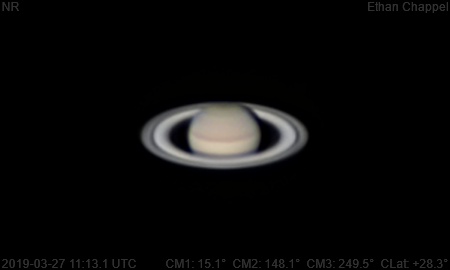
UTC
Despite the various issues I had imaging Jupiter, I decided to move on to Saturn. Since there was no alignment because of my earlier power issues, I had to manually aim at Saturn and track it with the hand controller.
Notes:
- The rings no longer peek over the north pole of the planet.
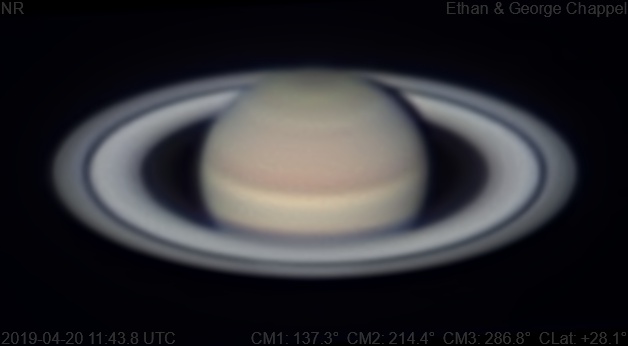
UTC
Seeing was a little better after moving on to Saturn from Jupiter, but nothing special.
Notes:
- There appears to be a faintly visible bright smudge visible near the north pole at the central meridian.
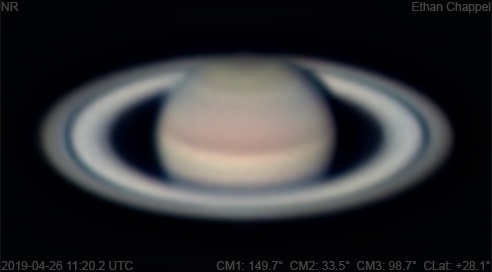
UTC
After a difficult start with Jupiter, I had an easier time with Saturn. As I was aiming the C8 towards the ringed planet, a few deer came into my area and started snorting at me.
Notes:
- There is a bright zone in the northern hemisphere.
- Far northern regions are green.
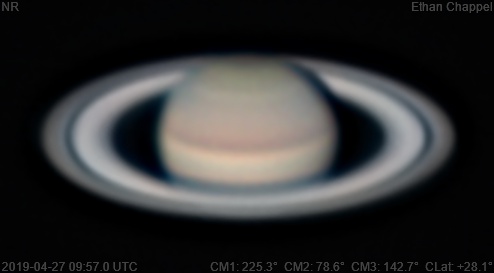
UTC
The seeing continued its months-long streak of being poor.
Notes:
- The far northern regions are green.
- One of the northern zones is particularly bright.
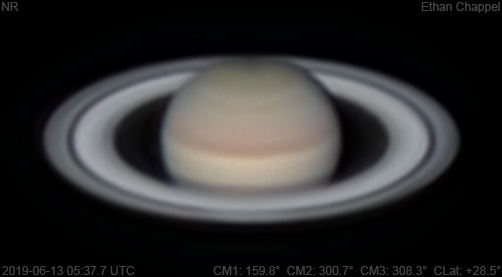
UTC
After a good round of imaging with Jupiter, I wanted to see if Saturn would any good despite being only 24° high. I'm doing another round of comparison between the ZWO and Chroma RGB filters. This image is with the Chroma filters, while the next one will be with the ZWO filters.

UTC
I swapped imaging trains again so I was capturing with the ZWO RGB filters. I want to see how they stack up to the Chroma equivalents used for the previous image. Seeing was surprisingly decent despite the somewhat low altitude and turbulent sky.

UTC
After a good run with Jupiter, I decided to turn my attention to Saturn as it approached transit.
Notes:
- A band at high latitudes is brighter compared to previous years.
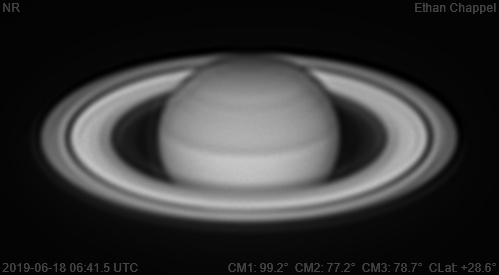
UTC
After an RGB run, I also gave Saturn the deep-red/infrared treatment.
Notes:
- A band at high latitudes is brighter compared to previous years.
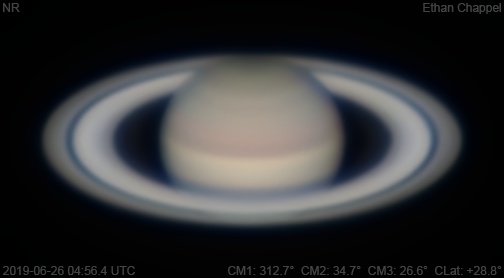
UTC
The seeing became surprisingly poor after I moved on from Jupiter.
Notes:
- High northern latitudes are green.

UTC
I noticed clouds were closing in while capturing methane images of Jupiter, so I hurried over to Saturn before it was too late to capture anything. The clouds reached Saturn before I started recording, but I managed to persist enough to capture an RGB set.
Notes:
- High northern latitudes are green.
- The North Temperate Zone is bright.
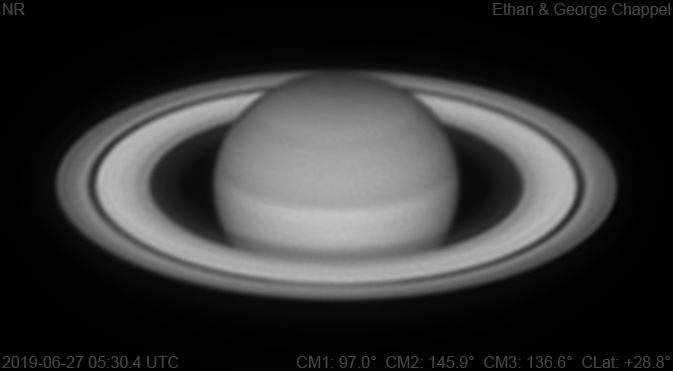
UTC
Despite being heavily obscured by clouds, I wasn't planning to give up as long as I could see Saturn on the screen, and it stayed visible long enough to capture enough near-infrared data for an image.
Notes:
- The North Temperate Belt stands out as being distinctly dark in an area with little contrast otherwise.
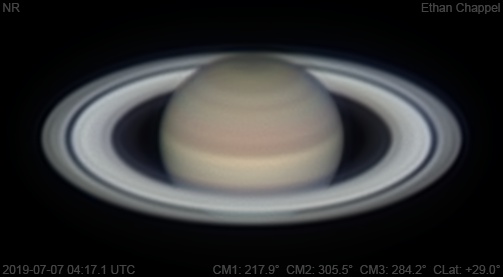
UTC
After collecting plenty of good Jupiter data, the view of Saturn did not disappoint either.
Notes:
- The north polar regions are green.
- With opposition soon arriving, the rings are starting to surge in brightness as the angle of reflection approaches 0°.

UTC
I decided to go for Saturn one more time tonight to take advantage of its higher altitude.
Notes:
- The north polar regions are green.
- With opposition soon arriving, the rings are starting to surge in brightness as the angle of reflection approaches 0°.
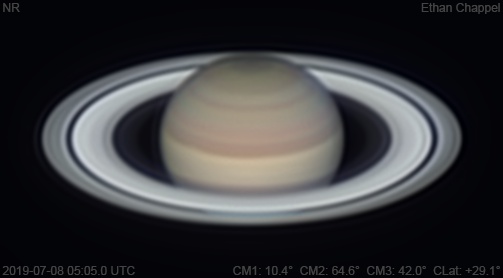
UTC
The great seeing and breezy conditions continued.
Notes:
- The north polar hexagon and its core is resolved.
- The far northern areas are green.
- The rings are continuing to brighten as opposition approaches, which is noticeable when compared to images from last night.
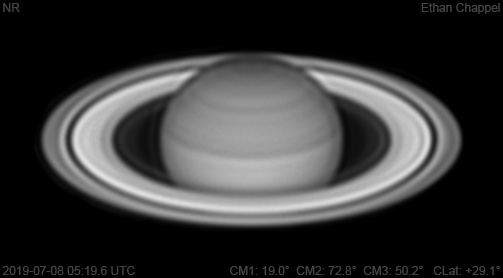
UTC
The great seeing and breezy conditions continued.
Notes:
- The north polar hexagon and its core is resolved.
- The north polar hexagon has a bright ring not visible in the RGB image.

UTC
Before calling it quits for the night, I decided to try for an image of Saturn with a methane filter.

UTC
It's opposition night for Saturn, and the first time I've imaged it on such a night in five years.
Notes:
- With twelve hours until opposition, the surge in brightness of the rings has nearly peaked.
- The northernmost regions of the planet are green-ish.

UTC
It's opposition night for Saturn, and the first time I've imaged it on such a night in five years.
Notes:
- With twelve hours until opposition, the surge in brightness of the rings has nearly peaked.

UTC
I decided to capture Saturn with the methane filter again after seeing how well it came out last night.
Notes:
- With twelve hours until opposition, the surge in brightness of the rings has nearly peaked.

UTC
Finally, a night that wasn't too breezy for the CGEM DX and C14. I thought the seeing was only a little above average while recording, but it turned out to be excellent.
Notes:
- The north polar hexagon and its core are resolved.
- A small niche on the edge of the Equatorial Zone is rising.

UTC
Finally, a night that wasn't too breezy for the CGEM DX and C14. I thought the seeing was only a little above average while recording, but it turned out to be excellent.
Notes:
- The north polar hexagon and its core are resolved.
- The clouds surrounding the core of the north polar hexagon are bright.
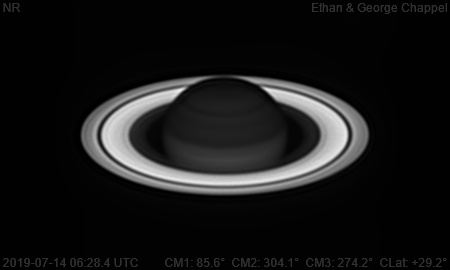
UTC
Finally, a night that wasn't too breezy for the CGEM DX and C14. I thought the seeing was only a little above average while recording, but it turned out to be excellent.
Notes:
- The Equatorial Zone holds a thin band brighter than the rest of the zone.
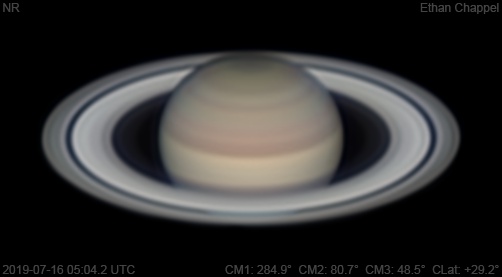
UTC
Another pretty good summer night with Saturn, though a little too breezy for the C14. The nearly full Moon was very close, causing the sky to look very bright through the eyepiece, though not enough to affect imaging.
Notes:
- The Equatorial Zone contains a thin and subtle band on the equator.
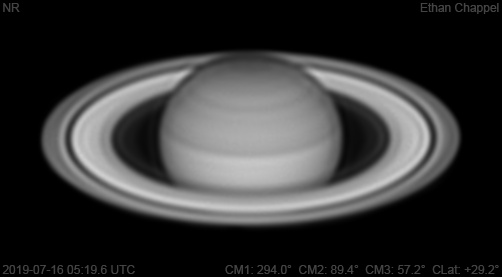
UTC
Another pretty good summer night with Saturn, though a little too breezy for the C14. The nearly full Moon was very close, causing the sky to look very bright through the eyepiece, though not enough to affect imaging.
Notes:
- The Equatorial Zone contains a thin and subtle band on the equator.
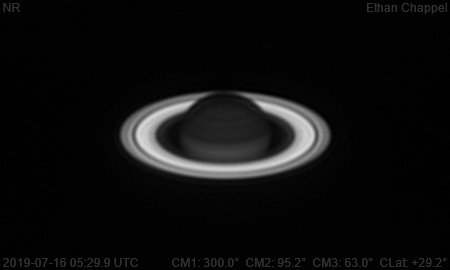
UTC
Another good summer night with Saturn, though a little too breezy for the C14. The nearly full Moon was very close, causing the sky to look very bright through the eyepiece, though not enough to affect imaging.
Notes:
- The Equatorial Zone contains a thin band on the equator, more visible in the methane band than visible light.
- Tethys is faintly visible near the one o'clock position relative to Saturn.
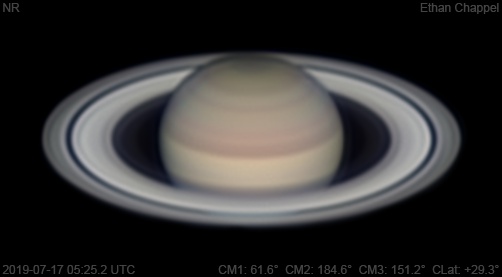
UTC
Like most nights this summer, it was slightly too windy for the CGEM DX/C14. Other than that, the conditions for imaging were great.
Notes:
- Far northern regions are green.
- The North Tropical Zone is thin and light.
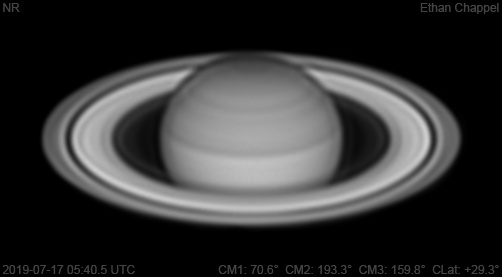
UTC
Like most nights this summer, it was slightly too windy for the CGEM DX/C14. Other than that, the conditions for imaging were great.
Notes:
- The North Tropical Zone almost blends in with the surrounding bands in near-infrared, but not in visible light.
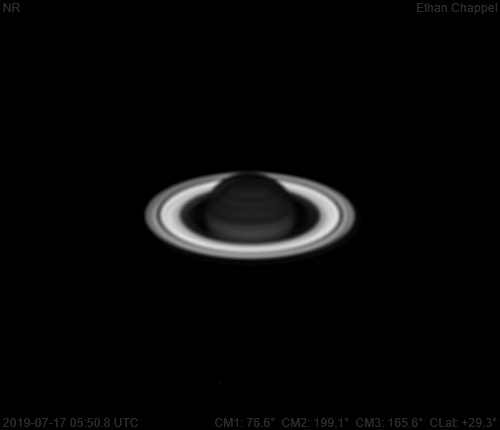
UTC
Like most nights this summer, it was slightly too windy for the CGEM DX/C14. Other than that, the conditions for imaging were great.
Notes:
- Dione is near the four o'clock position relative to Saturn. Rhea, and Tethys are near the six o'clock position. Enceladus should be near Tethys, but doesn't seem to be have been bright enough to be detected.

UTC
An excellent night for planetary imaging, with the usual caveat of being too breezy for using the CGEM DX/C14.
Notes:
- There's a subtle white smudge in the western side of the northern hexagon.
- The NEBn is well defined on its northern edge by the thin NTZ.
- The NEB is split by a subtle band, which is better defined in near-infrared.
- The EZ is also split by a thin gray band.
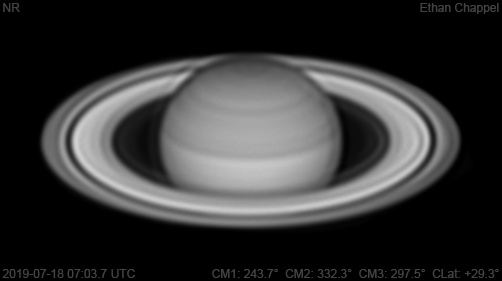
UTC
An excellent night for planetary imaging, with the usual caveat of being too breezy for using the CGEM DX/C14.
Notes:
- The north pole is circled by a bright donut in the hexagon.
- The NEB is clearly split in near-infrared, which is barely visible in visible light.
- The EZ is also split by a subtle and thin band.
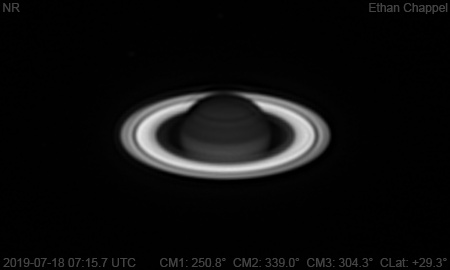
UTC
An excellent night for planetary imaging, with the usual caveat of being too breezy for using the CGEM DX/C14.
Notes:
- The EZ is split by a thin band, which is barely visible in visible light and near-infrared.
- Enceledus is just below the 9 o'clock position relative to Saturn, Dione is at 12 o'clock, and Tethys is between the two aforementioned moons, slightly closer to Dione.

UTC
Another good summer night of imaging for the AVX/C8.
Notes:
- The North Equatorial Belt is well defined on its northern edge by the thin North Temperate Zone.
- The Equatorial Zone is split by a thin gray band.
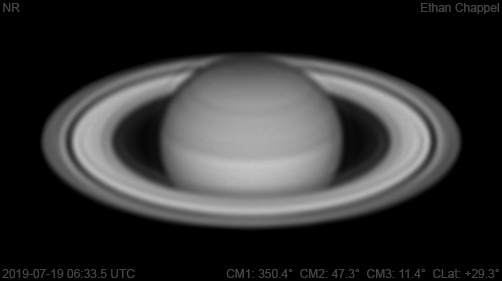
UTC
Another good summer night of imaging for the AVX/C8.
Notes:
- The North Equatorial Belt is split by a thin band.
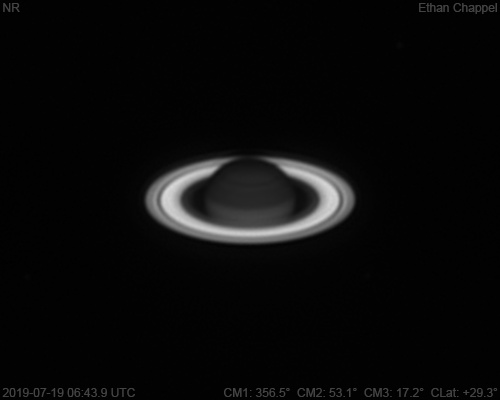
UTC
Another good summer night of imaging for the AVX/C8.
Notes:
- Rhea is faintly visible near the 1 o'clock position relative to Saturn. Dione is near the 8 o'clock position.
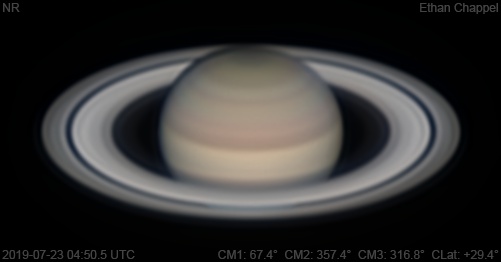
UTC
Another decent summer night of imaging Saturn.
Notes:
- The North Equatorial Belt is well-defined on its northern edge.
- The northernmost regions of the planet are still green.
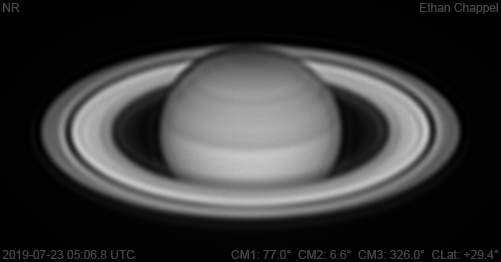
UTC
Another decent summer night of imaging Saturn.
Notes:
- The North Equatorial Belt is split by a thin band.
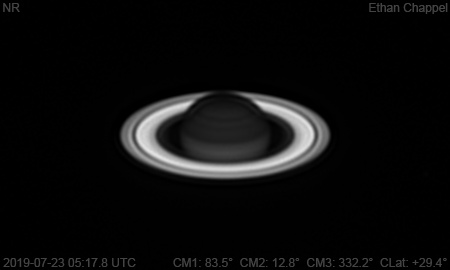
UTC
Another decent summer night of imaging Saturn.
Notes:
- The Equatorial Zone is split by a bright band.

UTC
Less windy conditions allowed us to use the CGEM DX/C14 for the first time in nine days. Seeing wasn't as good as most other nights this summer.
Notes:
- The northern regions of the planet are green.
- The North Equatorial Belt has a well-defined northern edge.

UTC
Less windy conditions allowed us to use the CGEM DX/C14 for the first time in nine days. Seeing wasn't as good as most other nights this summer.
Notes:
- The Equatorial Zone has a thin band on the equator.
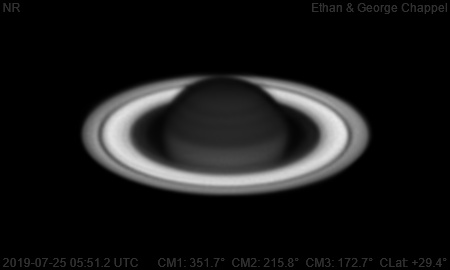
UTC
Less windy conditions allowed us to use the CGEM DX/C14 for the first time in nine days. Seeing wasn't as good as most other nights this summer.
Notes:
- The Equatorial Zone has a thin band on the equator that is barely visible in methane band tonight.

UTC
An excellent night of imaging to cap off July.
Notes:
- The northernmost regions are green.
- The North Equatorial Belt is split a faint band. This feature has been more visible in near-infrared the past few months.
- The Equatorial Zone is also split by a faint gray band on the equator.
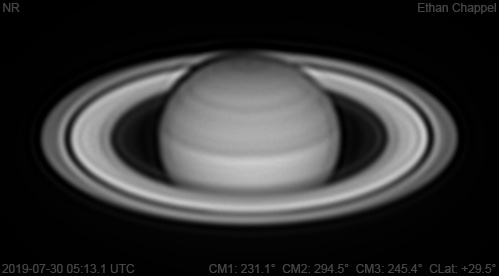
UTC
An excellent night of imaging to cap off July.
Notes:
- The hexagon has a bright ring around the north pole.
- The North Equatorial Belt is split by a band.

UTC
An excellent night of imaging to cap off July.
Notes:
- The Equatorial Zone is split by a bright band on the equator.
- Tethys, Dione, and Rhea are visible in a nearly straight line to the lower-left of Saturn. Mimas is also a part of the line, but not definitively visible in this image.
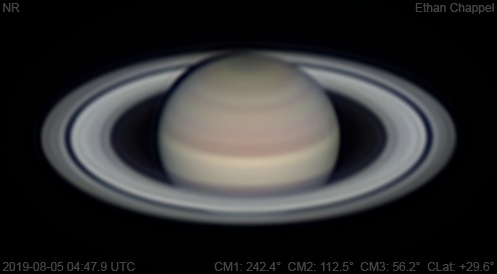
UTC
After imaging Jupiter with marginally good conditions, I encountered slightly better seeing while imaging Saturn.
Notes:
- The northernmost regions are green.
- The Equatorial Zone is split by a faint gray band on the equator.
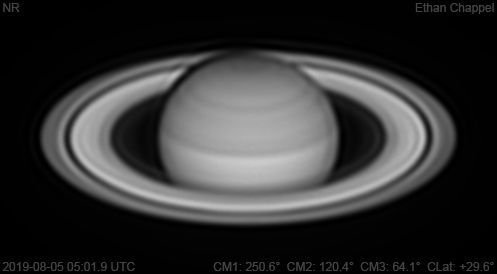
UTC
After imaging Jupiter with marginally good conditions, I encountered slightly better seeing while imaging Saturn.
Notes:
- The hexagon has a bright ring around the north pole.
- The North Equatorial Belt is split by a band.
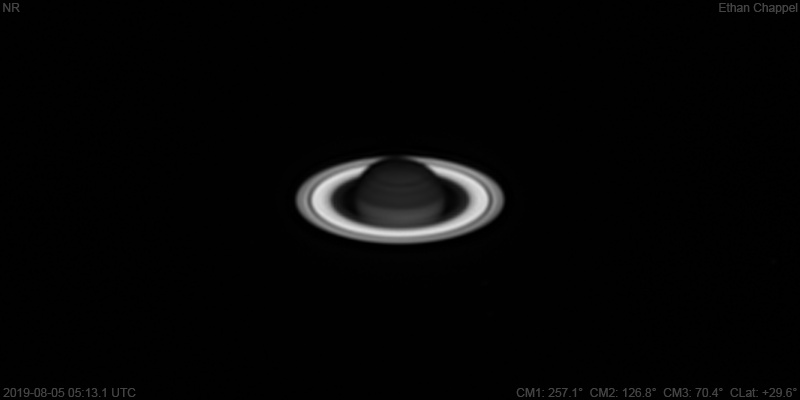
UTC
After imaging Jupiter with marginally good conditions, I encountered slightly better seeing while imaging Saturn.
Notes:
- The Equatorial Zone is split by a bright band on the equator.
- Rhea is far from Saturn at the 4 o'clock position. Tethys and Dione are at the 5 o'clock.
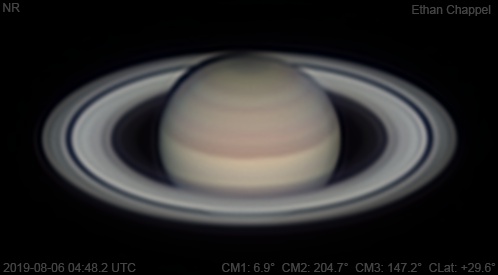
UTC
A night of great conditions aside from a slight breeze.
Notes:
- The northernmost regions are green.
- The North Tropical Zone is prominent.
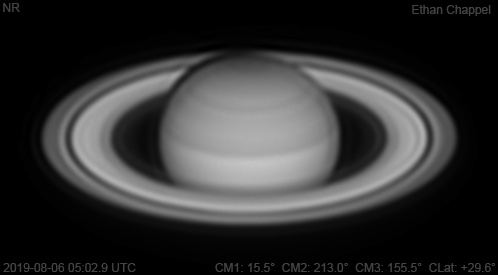
UTC
A night of great conditions aside from a slight breeze.
Notes:
- The North Equatorial Belt is split by a thin band.

UTC
A night of great conditions aside from a slight breeze.
Notes:
- Dione and Rhea appear to the upper-right of Saturn and Tethys is to the upper-left.
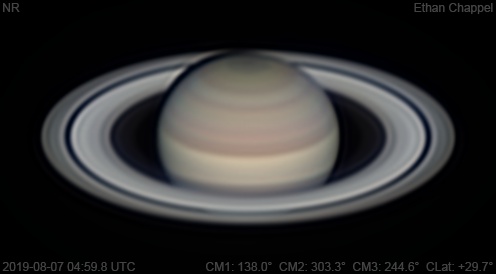
UTC
Excellent conditions for imaging, which I carried on with still unaware of catching the impact on Jupiter.
Notes:
- The hexagon and its dark core are resolved.
- The northernmost regions are green.
- The North Tropical Zone is bright.
- The North Equatorial Belt is split by a thin band.
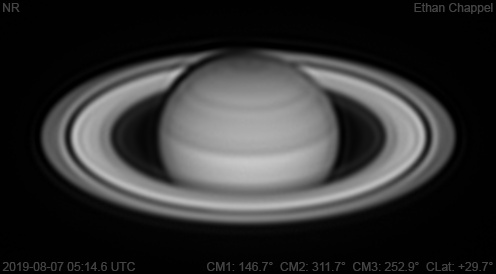
UTC
Excellent conditions for imaging, which I carried on with still unaware of catching the impact on Jupiter.
Notes:
- The hexagon has a bright ring around the north pole.
- The North Equatorial Belt is split by a thin band.

UTC
Excellent conditions for imaging, which I carried on with still unaware of catching the impact on Jupiter.
Notes:
- The Equatorial Zone is split by a bright band on the equator.

UTC
Another decent summer night for imaging Saturn with the C8 and Advanced VX.
Notes:
- The core of the northern hexagon is resolved.
- The North Polar Region has various shades of green.
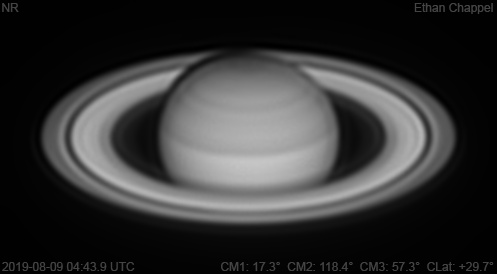
UTC
Another decent summer night for imaging Saturn with the C8 and Advanced VX.
Notes:
- The North Equatorial Belt continues to be split by a thin band.

UTC
Another decent summer night for imaging Saturn with the C8 and Advanced VX.
Notes:
- Dione appears above and behind Saturn, Enceladus is to the left, and Tethys is to the right.
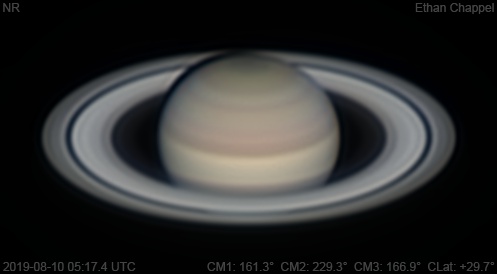
UTC
Slightly improved conditions compared to the previous night of imaging Saturn.
Notes:
- The North Polar Region is various shades of green.
- The North Tropical Zone is thin and bright.
- The North Equatorial Belt is split by a faint band.
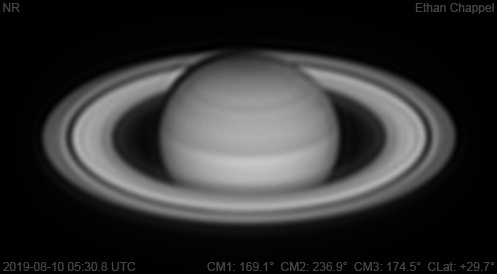
UTC
Slightly improved conditions compared to the previous night of imaging Saturn.
Notes:
- The North Equatorial Belt is split by a faint band.

UTC
Slightly improved conditions compared to the previous night of imaging Saturn.
Notes:
- The Equatorial Zone is split by a thin band.
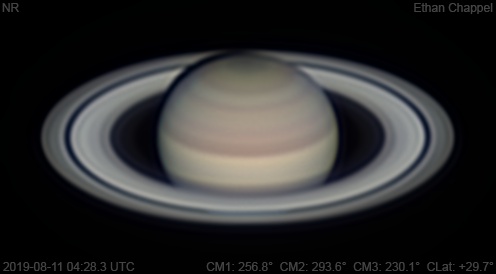
UTC
Improved conditions for imaging met me when moving on to Saturn from Jupiter.
Notes:
- The North Polar Region is green.
- The North North Temperate Belt is dark.
- The North Tropical Zone is thin and bright.
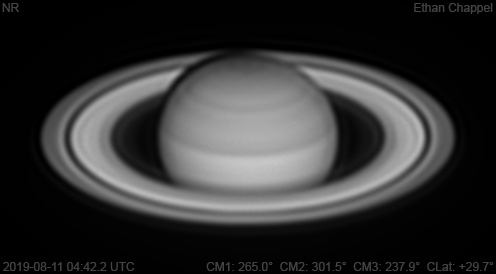
UTC
Improved conditions for imaging met me when moving on to Saturn from Jupiter.
Notes:
- The North Polar Hexagon has a bright ring inside it.
- The North North Temperate Belt is dark.

UTC
Improved conditions for imaging met me when moving on to Saturn from Jupiter.
Notes:
- The North North Temperate Belt is dark.
- The Equatorial Zone has a bright band on the equator.
- Enceladus, Tethys, and Dione are lined up to the right. Rhea above and behind Saturn.
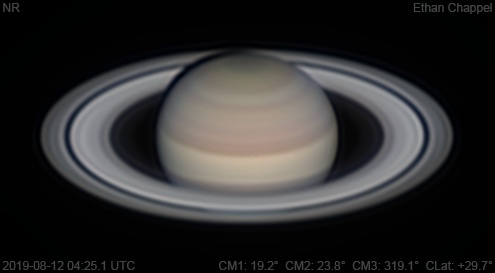
UTC
Relatively nice seeing and transparency compared to the high bar set in the past few months.
Notes:
- The North Polar Region is green.
- The North North Temperate Belt is dark.
- The North Tropical Zone is thin and bright.
- The North Equatorial Belt is split by a thin band.
- The Equatorial Zone is split by a faint gray band on the equator.

UTC
Relatively nice seeing and transparency compared to the high bar set in the past few months.
Notes:
- The North North Temperate Belt is dark.
- The North Equatorial Belt is split by a thin band.
- The Equatorial Zone is split by a faint gray band on the equator.
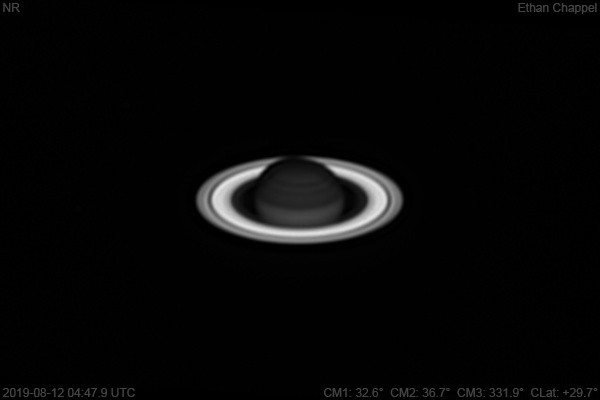
UTC
Relatively nice seeing and transparency compared to the high bar set in the past few months.
Notes:
- The North North Temperate Belt is dark.
- The Equatorial Zone is split by a faint gray band on the equator.

UTC
Excellent night for imaging the ringed planet, the only caveat being slight wind prohibiting use of the CGEM DX/C14 like many imaging sessions this summer.
Notes:
- The North Polar Region is green.
- The North North Temperate Belt is dark.
- The North Tropical Zone is thin and bright.
- The North Equatorial Belt is split by a thin band.
- The Equatorial Zone is split by a faint gray band on the equator.

UTC
Excellent night for imaging the ringed planet, the only caveat being slight wind prohibiting use of the CGEM DX/C14 like many imaging sessions this summer.
Notes:
- The northern hexagon has a bright ring within it.
- The North North Temperate Belt is dark.
- The North Tropical Zone is thin and bright.
- The North Equatorial Belt is split by a thin band.
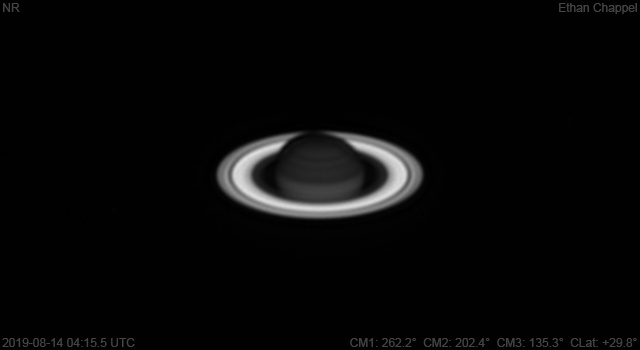
UTC
Excellent night for imaging the ringed planet, the only caveat being slight wind prohibiting use of the CGEM DX/C14 like many imaging sessions this summer.
Notes:
- The North North Temperate Belt is dark.

UTC
A good night for imaging Saturn after missing a few to bad weather. Seeing improved by the time I moved on from Jupiter. I forgot to capture methane band images of Saturn this night.
Notes:
- The North Polar Region is green.
- The North North Temperate Belt is dark.
- The North Tropical Zone is thin and bright.

UTC
A good night for imaging Saturn after missing a few to bad weather. Seeing improved by the time I moved on from Jupiter. I forgot to capture methane band images of Saturn this night.
Notes:
- The northern hexagon has a bright ring within it.
- The North North Temperate Belt is dark.
- The North Equatorial Belt is split by a thin band.

UTC
Although seeing started great for Jupiter, it worsened a bit by the time I moved on to Saturn. Nevertheless, it was still a good night.
Notes:
- The North Polar Region is green.
- The North North Temperate Belt is dark.
- The North Tropical Zone is thin and bright.
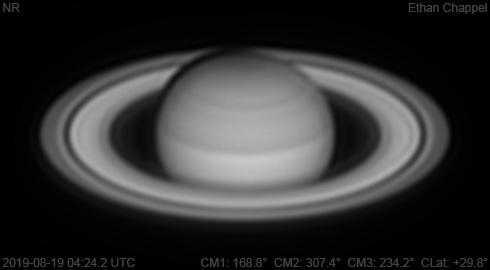
UTC
Although seeing started great for Jupiter, it worsened a bit by the time I moved on to Saturn. Nevertheless, it was still a good night.
Notes:
- The northern hexagon has a bright ring within it.
- The North North Temperate Belt is dark.
- The North Equatorial Belt is split by a thin band.

UTC
Although seeing started great for Jupiter, it worsened a bit by the time I moved on to Saturn. Nevertheless, it was still a good night.
Notes:
- The North North Temperate Belt is dark.
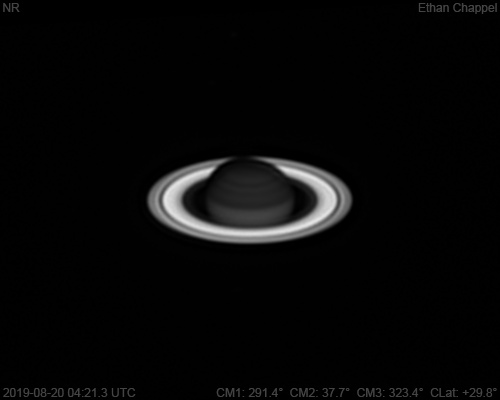
UTC
Unlike most nights, I started imaging Saturn with the methane band filter since the C8 was already focused for imaging without a barlow.
Notes:
- The North North Temperate Belt is dark.
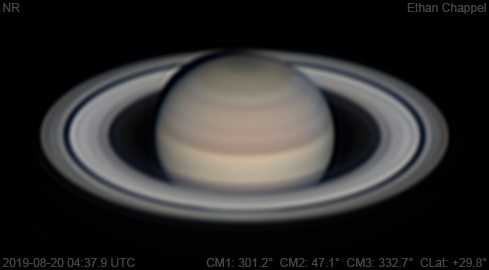
UTC
Unlike most nights, I started imaging Saturn with the methane band filter since the C8 was already focused for imaging without a barlow.
Notes:
- The North Polar Region region has various shades of green.
- The North North Temperate Belt is dark.
- The North Tropical Zone is thin and bright.

UTC
Unlike most nights, I started imaging Saturn with the methane band filter since the C8 was already focused for imaging without a barlow.
Notes:
- The North North Temperate Belt is dark.
- The North Equatorial Belt is split by a thin band.
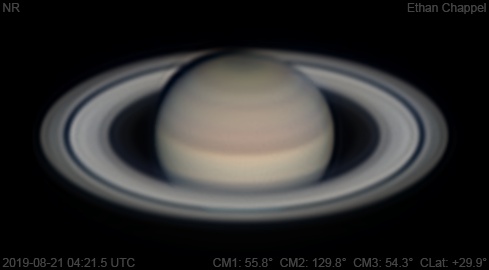
UTC
Unlike last night, I started imaging Saturn with RGB and ended with methane band, as is typical for me.
Notes:
- The North Polar Region has various shades of green.
- The North North Temperate Belt is dark.
- The North Tropical Zone is thin and bright.
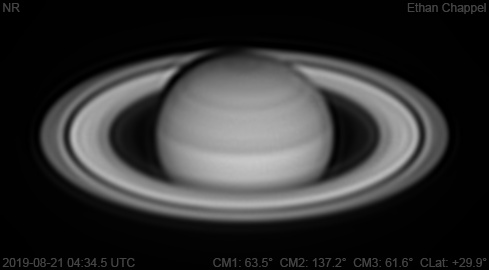
UTC
Unlike last night, I started imaging Saturn with RGB and ended with methane band, as is typical for me.
Notes:
- The North Polar Hexagon has a bright ring inside it.
- The North North Temperate Belt is dark.
- The North Equatorial Belt is split by a thin band.
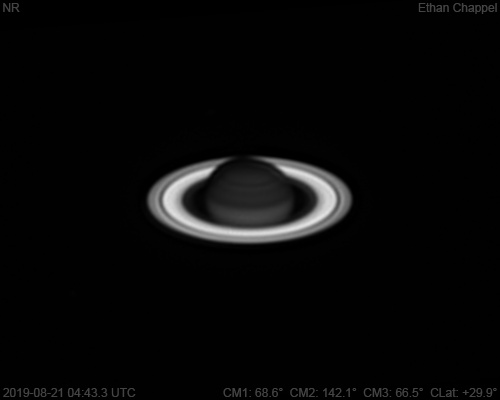
UTC
Unlike last night, I started imaging Saturn with RGB and ended with methane band, as is typical for me.
Notes:
- The North North Temperate Belt is dark.
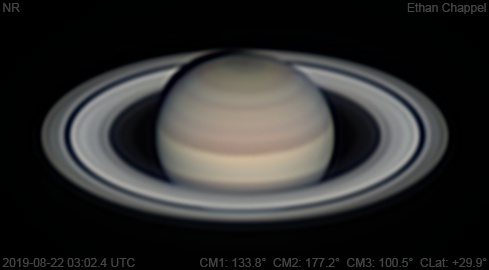
UTC
An excellent night for imaging Saturn again with the C8.
Notes:
- The north polar hexagon is resolved. The dark core is also visible.
- The North Polar Region is various shades of green.
- The North North Temperate Belt is dark.
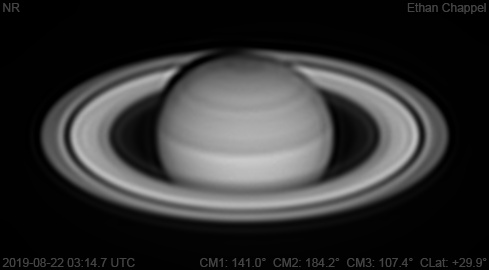
UTC
An excellent night for imaging Saturn again with the C8.
Notes:
- The north polar hexagon is resolved. The dark core is surrounded by a bright ring.
- The North North Temperate Belt is dark.
- The North Equatorial Belt is split by a thin band.
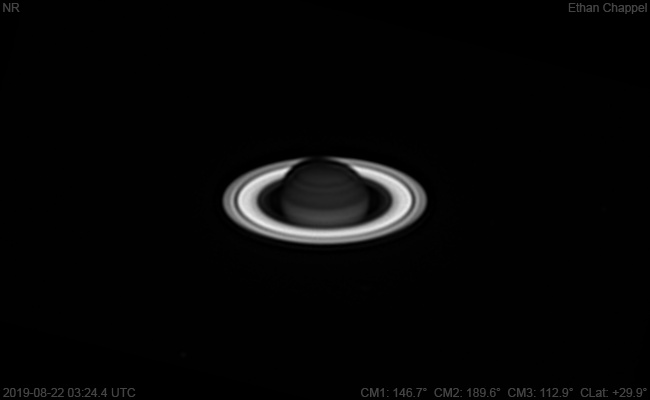
UTC
An excellent night for imaging Saturn again with the C8.
Notes:
- The North North Temperate Belt is dark.
- The Equatorial Zone is split by a thin band on the equator.

UTC
My first time since late-April imaging next to a parking lot at my university. Conditions were better for Saturn than for Jupiter. The gusts of wind were intense enough to push my laptop off the table if I didn't hold it down.
Notes:
- The North Polar Region is various shades of green.
- The North North Temperate Belt is dark.

UTC
Conditions for imaging were poor again. I had to wait for some clouds to disperse before moving on from Jupiter to Saturn. Like last imaging session, there were issues with intense heat currents coming off the C8 because it was much warmer than the ambient temperature.
Notes:
- The North Polar Region is various shades of green.
- The North North Temperate Belt is dark.
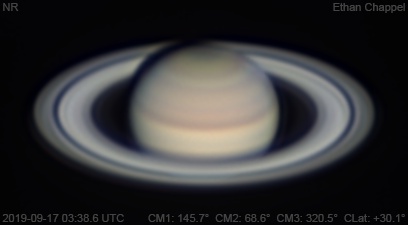
UTC
I wasn't sure I would get the chance to record Saturn since the southern part of the sky was covered when I finished imaging Jupiter, but it worked out after some patience.
Notes:
- The North Polar Region has various shades of green.
- The North North Temperate Belt is dark.
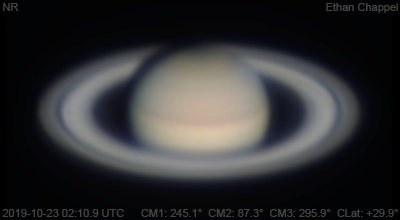
UTC
After showing some people Jupiter while imaging it at a star party, I gave Saturn the same treatment.
Notes:
- The North Polar Region is various shades of green.

UTC
Even though seeing was bad while imaging Venus, I decided there was no loss in trying Saturn too. I was surprised by the extreme surface brightness difference between both planets.